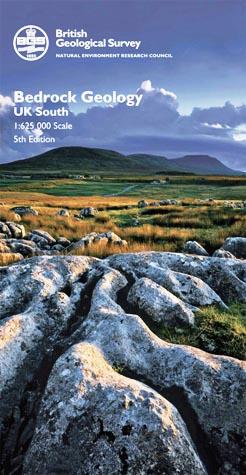
How it was done
This new edition has been created by generalisation of the latest 1:50 000 scale digital geological data for England, Wales and Scotland, and the 1:250 000 scale data for Northern Ireland. The data were first interrogated to provide digital selections of associated rock units, of all ranks, based on their stratigraphic correlations, hierarchies and lithologies in order to rationalise the multitude of beds, members, formations and groups, and the intrusive and extrusive rocks. Once established, the generalised digital selections were displayed in colour in order for a cartographic generalisation to be carried out. This cartographic generalisation was informed by the rock classification, emphasising important small units where necessary. The map is consistently more spatially accurate than previous editions, with more intricate linework possible. Many more faults are shown, including thrusts, and the classification and depiction of dykes is improved.
The most obvious change on the new edition is in the key and the system for labelling geological units. The single column of boxes seen on earlier editions is replaced by a main column on the left, supplemented by additional columns to the right, where necessary, to show regional variation. This allows some of the geological complexity (best illustrated by BGS’s new Stratigraphical Chart of the United Kingdom – see below) to be seen in simplified form. The single sequence of numbers from 1 to 115, first used to unify the geology of the UK on the third edition, is here replaced by a system of letters and numbers. Again this echoes the first edition, where sedimentary units in England and Wales were labelled with letters.
Rather than reinstate these, as they did not include the ‘Precambrian’, an existing alternative was adopted and modified. Thus the initial letter of each geological period is used as the primary identifier. Ordovician rocks are labelled with an ‘O’, Carboniferous with a ‘C’ and duplication is avoided by using established alternatives: ‘E’ for Cambrian and ‘K’ for Cretaceous. Within each period, units are numbered sequentially upwards, based on the chronostratigraphy or lithostratigraphy, whichever is most practicable, so that rocks of the same age, or approximately equivalent, have the same number. A further benefit of this scheme is its flexibility; in future editions of the map it will easy to revise the stratigraphy by adding or removing units as appropriate.
- The digital vector data for the earlier fourth edition Bedrock (and first edition Quaternary) are both available free of charge for non-commercial uses from the BGS website at: www.bgs.ac.uk/products/digitalmaps/data_625k.html
- It is planned to make the new 5th edition Bedrock geological data similarly available as soon as possible. The new maps (flat or folded) and booklets are available separately from BGS, price £10 each or £15 for a map and accompanying booklet package; and the folded map and booklet come in a plastic wallet.
- Visit www.geologyshop.com E: [email protected]